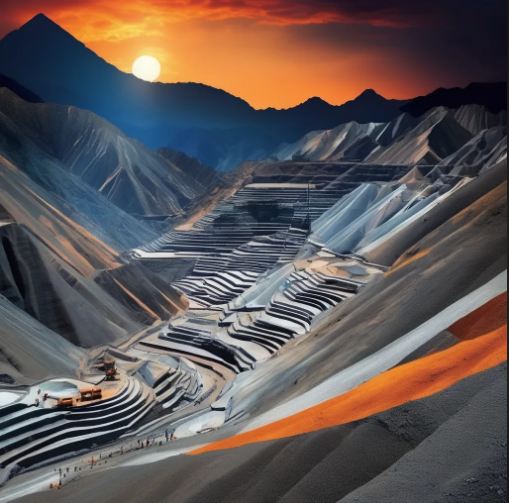Introduction
India is a country rich in natural resources, and minerals are an essential component of its economic growth and development. The country’s vast mineral wealth contributes significantly to its industrial growth, infrastructure development, and overall economic advancement. India is one of the world’s largest producers and consumers of minerals, with a diverse range of mineral resources that include coal, iron ore, bauxite, copper, zinc, gold, and various other industrial minerals.
However, despite the rich mineral deposits, India’s mineral development has faced several challenges, including outdated policies, inefficiencies in extraction and management, and environmental concerns. To address these issues and promote sustainable mining practices, India has formulated a comprehensive Mineral Development Policy. This policy aims to optimize the utilization of mineral resources while promoting environmental sustainability, improving governance, and ensuring equitable benefits for all stakeholders.
In this article, we will delve into India’s mineral development policy, its evolution, key objectives, and the various challenges and opportunities associated with mineral development in the country.
Evolution of India’s Mineral Development Policy
India’s approach to mineral development has undergone significant transformations since its independence in 1947. Initially, the focus was on promoting mineral exploration, extraction, and processing to meet the demands of a growing economy. However, over the years, the policy has evolved to address emerging challenges, including environmental degradation, the need for sustainable development, and the promotion of private sector participation in mining.
The early years post-independence saw the establishment of public sector mining companies, such as National Mineral Development Corporation (NMDC) and Steel Authority of India Limited (SAIL), which played a key role in mining and processing minerals. In the 1970s and 1980s, mining operations in India were largely regulated by the government, with a focus on achieving self-sufficiency in mineral production.
In the 1990s, with the economic liberalization of India, the government began to encourage private sector involvement in the mining sector. This shift in policy led to the opening up of the mining sector to both domestic and foreign investors, with a focus on improving mining technologies, infrastructure, and governance.
Key Objectives of India’s Mineral Development Policy
The primary aim of India’s mineral development policy is to ensure optimal utilization of the country’s mineral resources for the sustainable development of the economy. Some of the key objectives of the policy are as follows:
1. Optimal Utilization of Mineral Resources
The mineral resources of India are finite, and their extraction and utilization need to be done in a manner that ensures sustainability. The policy aims to make the most efficient use of available mineral resources to meet the needs of various industries, such as steel, power generation, cement, and electronics. The policy encourages the development of value-added products from minerals to enhance the contribution of the mining sector to the economy.
2. Promoting Sustainable Mining Practices
One of the core principles of the mineral development policy is to ensure that mining is conducted in an environmentally sustainable manner. This involves adopting practices that reduce the environmental impact of mining activities, such as minimizing land degradation, water contamination, and air pollution. The policy emphasizes the need for rehabilitation and reclamation of mined areas and reforestation to mitigate environmental damage.
3. Attracting Investment and Technological Advancement
The policy aims to attract both domestic and foreign investment in the mining sector, with a focus on introducing advanced mining technologies, exploration techniques, and modern management practices. By incentivizing private sector participation, India aims to enhance the efficiency and productivity of its mining operations.
4. Ensuring Regional Development and Inclusive Growth
The development of mineral resources often occurs in remote and underdeveloped regions, which creates an opportunity for regional development. The policy seeks to ensure that mining activities contribute to the socio-economic development of these regions, creating jobs, infrastructure, and community welfare programs. Additionally, it aims to address the concerns of local communities and ensure that the benefits of mineral development are distributed equitably.
5. Strengthening Governance and Transparency
One of the main challenges facing India’s mining sector has been the lack of transparency and governance issues, such as illegal mining, corruption, and inefficiencies in mineral allocation. The mineral development policy seeks to address these concerns by promoting transparency in the allocation of mining licenses, adopting clear regulatory frameworks, and implementing stronger enforcement mechanisms to prevent illegal mining activities.
6. Ensuring National Security and Strategic Mineral Supply
India’s increasing reliance on imported minerals, such as rare earth elements, has raised concerns about the security of mineral supply. The policy seeks to ensure that India maintains a strategic reserve of essential minerals and reduces dependence on imports by promoting domestic exploration, production, and processing capabilities.
7. Promoting Research and Development
To support the long-term growth and sustainability of the mining sector, the policy encourages research and development (R&D) in mineral exploration, extraction technologies, and mineral processing techniques. By fostering innovation, the policy aims to improve the efficiency and profitability of mining operations.
Key Features of India’s Mineral Development Policy
India’s mineral development policy is centered around several features that are crucial for achieving its objectives. These features include:
1. Mineral Exploration and Licensing
The policy emphasizes the need for geological surveys and mineral exploration to identify new mineral reserves and ensure the availability of resources for future development. The government has established various institutions like the Geological Survey of India (GSI) and the Indian Bureau of Mines (IBM) to promote exploration activities.
The Mining and Mineral Laws (Amendment) Act, 2015 introduced a new approach to mineral licensing in India. It moved from a system of discretionary allotment to a more transparent auction-based system for the allocation of mineral resources. This shift aims to reduce corruption and ensure fair competition in the mining sector.
2. Environmental Management and Sustainability
The policy emphasizes the importance of environmental management in the mining sector. It mandates the submission of Environmental Impact Assessments (EIA) and Environmental Management Plans (EMP) for all mining projects. Furthermore, mining companies are required to invest in land reclamation, water conservation, and pollution control measures to minimize the adverse environmental impacts of mining.
3. Community Welfare and Corporate Social Responsibility (CSR)
India’s mineral development policy places significant importance on the welfare of communities living in mining areas. Mining companies are required to contribute to the development of local infrastructure, health, education, and sanitation facilities. The policy encourages companies to implement Corporate Social Responsibility (CSR) initiatives to uplift local communities and ensure that they benefit from mining activities.
4. Infrastructure Development
Efficient infrastructure is crucial for the smooth functioning of the mining industry. The mineral development policy promotes the development of transport and logistics infrastructure, including roads, railways, ports, and power supply, to facilitate the movement of raw materials from mines to processing units and markets.
The government has also invested in the development of mineral processing hubs and industrial corridors to create synergies between mining activities and related industries, such as steel, cement, and power.
5. Private Sector Participation
With the aim of enhancing the efficiency and competitiveness of the mining sector, the policy actively promotes private sector participation. Private companies are encouraged to invest in mineral exploration, mining operations, and processing, with incentives provided in the form of tax breaks and concessions. Additionally, the policy emphasizes public-private partnerships (PPP) to bring in both technical expertise and financial resources.
Challenges in Mineral Development
Despite the well-structured policy framework, India’s mineral development faces several challenges that hinder its growth:
1. Environmental Concerns
Mining activities are often linked to deforestation, land degradation, and water pollution. The growing demand for minerals, combined with the lack of effective enforcement of environmental laws, has led to widespread environmental damage in many mining regions.
2. Illegal Mining
Illegal mining is a major issue in India, particularly for minerals like coal and sand. Illegal mining not only leads to revenue loss for the government but also causes environmental destruction and undermines the safety of workers.
3. Land Acquisition Issues
Land acquisition for mining projects often leads to conflicts with local communities. The displacement of indigenous populations and the loss of agricultural land can lead to social unrest and resistance to mining activities.
4. Infrastructure Deficiencies
While infrastructure development is a key component of the policy, India still faces significant challenges in building efficient and cost-effective infrastructure, particularly in remote mining regions.
5. Global Competition
India faces stiff competition from other mineral-rich countries, particularly China, which dominates the global market for several minerals, such as rare earth metals. India’s mineral development policy needs to ensure that the country remains competitive in the global market by fostering technological advancements and innovation in mining practices.
Opportunities in Mineral Development
India’s mineral development sector holds immense potential for growth and progress. Some of the key opportunities include:
- Increasing Domestic Production: By focusing on domestic exploration and production, India can reduce its dependency on imported minerals and enhance self-sufficiency in key sectors like steel and energy.
- Technological Advancements: The adoption of advanced mining technologies, such as automation, artificial intelligence, and data analytics, can improve the efficiency and sustainability of mining operations.
- Expanding Value-Added Products: There is significant potential for expanding the processing and production of value-added mineral products, which can contribute to higher revenues and job creation.
- Promoting Sustainable Mining Practices: With increasing global attention on environmental sustainability, there is a growing opportunity for India to adopt green mining technologies that minimize environmental impact and promote sustainability.
Conclusion
India’s mineral development policy plays a critical role in shaping the future of the country’s mining sector. With its focus on efficient resource utilization, sustainability, and social welfare, the policy provides a roadmap for the development of the mineral sector in a manner that benefits the economy, environment, and society. While there are challenges that need to be addressed, the opportunities for growth, investment, and innovation in the sector are immense. By strengthening governance, promoting transparency, and fostering private sector participation, India can unlock the full potential of its mineral resources and secure a strong economic future.




